I remember witnessing as a kid large numbers of Short-eared Owls flying out at dusk. About 30 years ago, on my first excursions as a birder to the coast, I observed several times up to 15 Sort-Eared Owls flying out in a relatively small area South of the Port of Zeebrugge. Most of the birds were resting during daytime in the reedbeds along small canals in the polders or in the brushwood on a vast industrial site with wasteland, dunes, ponds and marshes. I remember very well being being mesmerized by the number Owls who kept on coming out at dusk. I wasn’t part at that time of a large social network briefing each other about how many special birds were present in a particular spot. I knew Short-eared Owls were often present in the area, but in the field I was very surprised by the large numbers of this species. Later I heard that in the seventies and eighties, during the best years up to 30 Short-eared Owls were present in both of the core wintering areas in Flanders, Uitkerke and Zeebrugge – Dudzele.
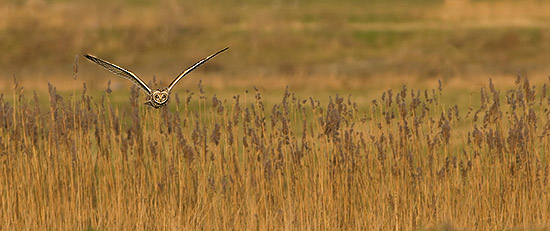
Invasive and nomadic character
The past decades things have changed severely… Almost the entire area in Dudzele and Zeebrugge where I saw the Owls has meanwhile been replaced by industrial expansion of the Port. Luckily the other core area was better preserved and developed as a nature reserve. But outside Flanders things have also changed: the former Dutch Short-eared Owl breeding population has completely crashed and the entire European population has suffered severe declines. However, as Short-eared Owl populations appear to show a very nomadic character and the Owls seem often able to locate temporal and local abundant mice populations. The past ten years during some years the polder of Uitkerke was visited by tens of Short-eared Owls. 2008 was the last year with really spectacular numbers of Owls, a local census mentioned the presence of 20 individuals.
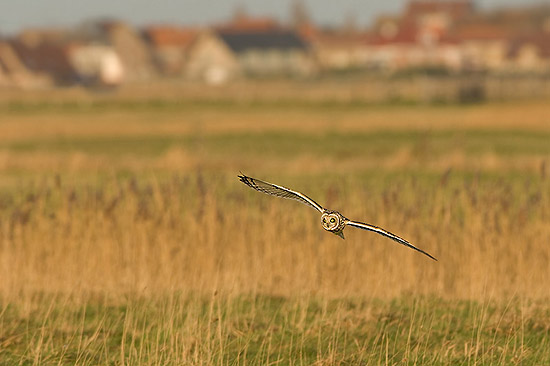
The mystery of day-active populations
Short-eared Owl is known to be the most day-active Owl in Western Europe. Typical behaviour of both Long-eared and Short-eared Owl, is that when their offspring is still very young, the adults already start to hunt during daytime, often one or two hours before sunset. This diurnal behaviour only lasts for a very short period. Outside this period, adults are often only sporadically seen hunting during daytime. This can happen when food becomes more scarce, such as after snowfall or after long periods of very bad weather and the birds weren’t able to hunt properly. Strangely the wintering birds in Uitkerke seem to belong to one of the few populations which often show regular and pretty predictable diurnal activity. 2008 was a ‘gifted year’ for bird photographers in Uitkerke, as the birds often already started to hunt between 3 and 5 p.m. In other years the diurnal hunting periods were often less frequent and hardly predictable. During the winter of 2011-2012, Short-eared Owls were very abundant in a nature development area with abandoned farmland near the port of Antwerp. Up to 13 Owls were residing in a very small area of not much more than 50 hectares. Despite visiting the area at least 8 times, I only observed once the Owls flying out a little before sunset. On all the other visits the Owls only started to hunt when daylight had by long vanished… The explanation for these behavioural differences between the sites and between the different years remains unknown. One would expect that when prey densities are lower, the Owls have to start to hunt earlier to gather enough food. But it is only during years with abundant mice populations that Short-eared Owls are present in decent numbers. Why do they hunt in one site during daytime and do the birds 20 kilometres further only start to hunt at dusk? Still a lot of questions remain and a lot of study still needs to be done… Anyway, I always enjoy the wonderful spectacle of hunting Short-eared Owls in the beautiful winter light.
Under here some of my favourite images of hunting Short-eared Owls.



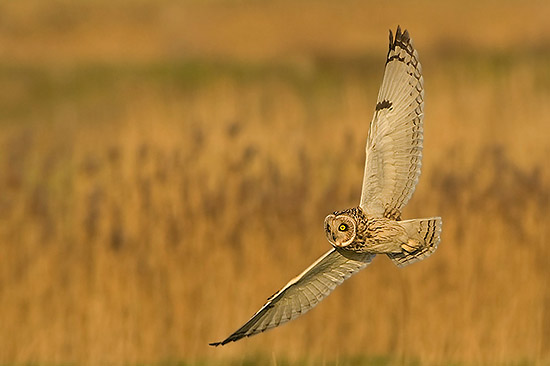
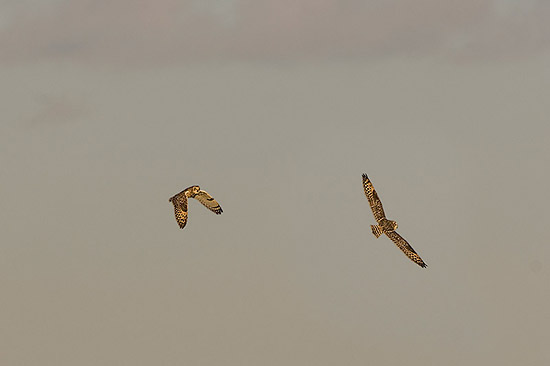
The social phenomenon
Here an image of the – in my opinion – less attractive side of the story. The week after I took the images I decided to visit Uitkerke again and I was struck by the herds of drumming photographers, each hoping for their part of glory on the internet… But, who am I to judge? I was standing there as well and now I am writing a story on my blog about it as well… The less attractive side is that people who visit the site for its relative quietness, were now confronted with hundreds of photographers parking their cars all along the small roads. Moreover some of them were running all over the place, sometimes even crossing the fences of the nature reserve and causing the large groups of grazing geese to fly up. Socially definitely a fascinating phenomenon, but not exactly my idea of spending spare time during the weekend…
I took almost no pictures on my second visit as the birds had become more alert, probably due to the constant presence of some nervous photographers making sudden movements each time a bird showed up in another direction then their camera set-up. I went of and decided to focus on the large Pink-footed and White-fronted Goose groups, which were present at close vicinity of the Owl site. I left the site with mixed feelings and decided not to come back for a while.
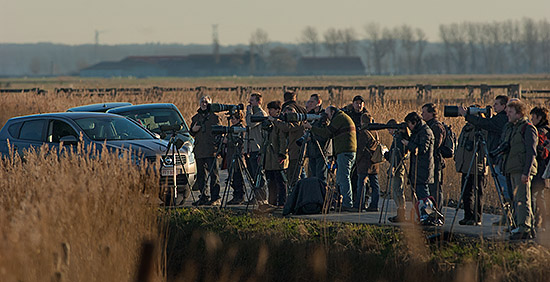
Uitkerke revisited
During the next years I paid the site a few new visits, my fascination for the Owls and the wonderful site gained it from the distaste due to my last experience… Luckily things seemed to have downsized to normal proportions and I was happy to try out some new type of images – without being confronted with dozens of other photographers.
Under here an image of a Short-eared Owl taken on an ice cold and very windy day. Only two Owls flew out about twenty minutes after sunset, but luckily one bird was hovering constantly against the strong wind and just along the road. Moreover the individual was incredibly tame and cooperative… My hands were freezing off and I had the greatest difficulties aiming the bird and focussing manually, while holding my flash away from my camera to avoid the red-eye effect.
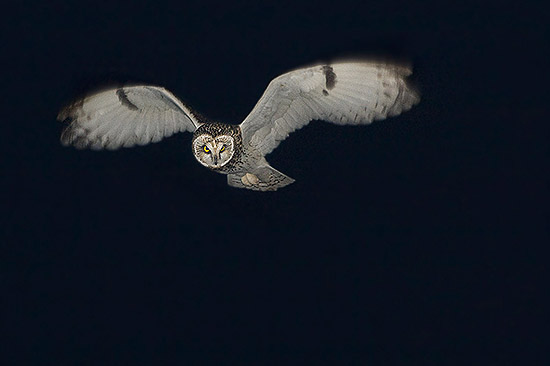
On another year I visited the site again during a period of frost and snow. Under here two images of the beautifully lit owls in the reflections of the snow.
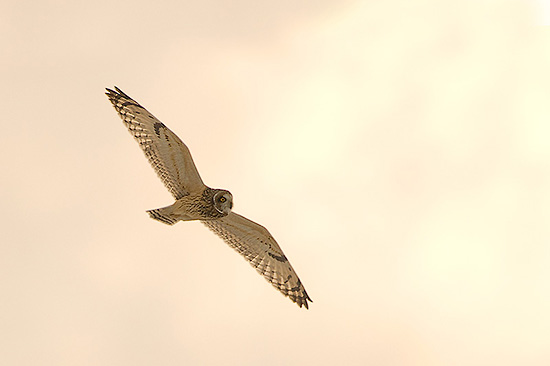
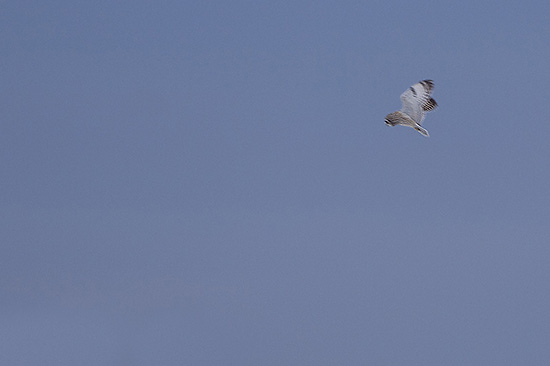
If you want to view the images on a larger scale, please click here.
